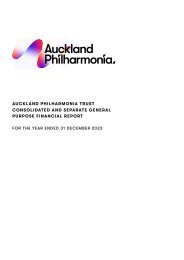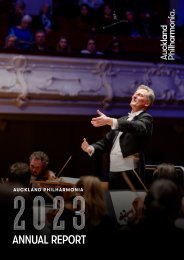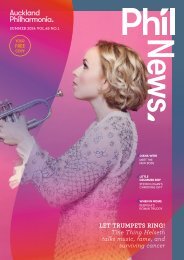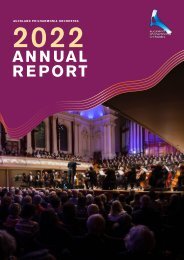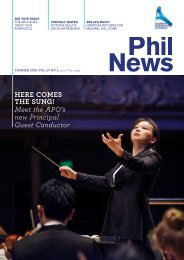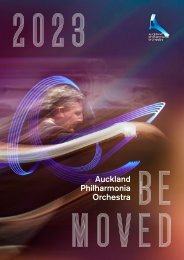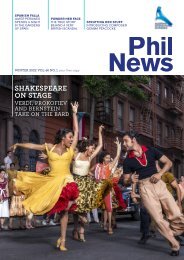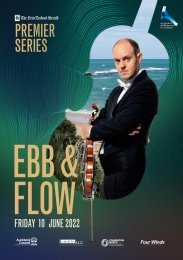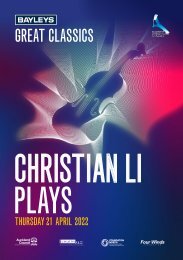Create successful ePaper yourself
Turn your PDF publications into a flip-book with our unique Google optimized e-Paper software.
apo.co.nz<br />
“It will be interesting and quick and<br />
over-stimulating for children for around<br />
50-60 minutes and then they can head on<br />
their way!” Sainsbury says, half joking.<br />
Dynamotion is a comedy dance troupe<br />
that puts on a themed show every year.<br />
“The comedy comes first and the<br />
dancing comes second,” says Tom, “but<br />
we always try getting the dancers really<br />
good. We have a narrative, and dance<br />
to pop songs or rock’n’roll and country<br />
music. The last show we did was a kind<br />
of Western-inspired show all about the<br />
big themes, revenge and love and with<br />
shoot-’em-ups, and it was kind of camp<br />
and ridiculous with colourful costumes.<br />
The one we did before that was James<br />
Bond-inspired, and we’ve also done one<br />
that was Terminator-inspired. The last<br />
show, I was tied up to a cactus and we<br />
had five of the dancers dressed up as<br />
cactuses dancing around a totem pole.<br />
And three of us played a pig, so the<br />
style lends itself to us kind of embodying<br />
these animals.”<br />
As for Dynamotion’s plans for Carnival<br />
of the Animals, Tom says he’s most<br />
excited about doing a Fossil dance.<br />
“Also, I think Aquarium and Aviary will<br />
be beautiful and quite good to do. Others<br />
are proving to be a great challenge, like<br />
Chicken and the Wild Donkey. We’ll<br />
be doing lots of costume changes and<br />
interpretive bodies becoming the animals<br />
and we’ll have some puppets too.”<br />
Tom Sainsbury is one of our most<br />
high profile and much-loved comedians,<br />
and <strong>Phil</strong> <strong>News</strong> caught him just after the<br />
closing of the annual Comedy Festival, in<br />
which he performed a stand-up routine<br />
called Gone Bananas. That’s not the<br />
half of it. He’s in a multi-tasking class of<br />
his own with a CV bursting with acting<br />
credits, screenplays for TV series, several<br />
books and, most popular of all, his regular<br />
Snapchat satire, in which he uses visual<br />
technology to impersonate the characters<br />
of some of Aotearoa’s least-liked media<br />
and political personalities.<br />
Not a musician himself, Tom admits<br />
that music is actually his favourite thing<br />
of all, and says he grew up in a house in<br />
rural Matamata where Vivaldi’s The Four<br />
Seasons was the soundtrack.<br />
“We played it on repeat all the time<br />
and really got into the dramatics of it. And<br />
I was a huge fan of [Prokofiev’s] Romeo<br />
and Juliet ballet music. I like indulging in<br />
the big emotions that come with that. And<br />
Wagner? That’s the peak of drama, right?<br />
Yes of course, I love it!”<br />
Having recently returned from LA<br />
where he was pitching several ideas<br />
for TV shows, Kiwis should enjoy him<br />
while we still can, and the wildly amusing<br />
Dynamotion performance accompanying<br />
Carnival of the Animals will be a<br />
chance to enjoy his unpredictable<br />
creative genius.<br />
Carnival of<br />
the Animals<br />
11.30am & 2pm,<br />
Saturday 12 August<br />
Auckland Town Hall<br />
apo.co.nz/carnival-animals<br />
All about<br />
Carnival Of The Animals<br />
CAMILLE SAINT-SAËNS<br />
Composing music in the European<br />
classical tradition was a serious<br />
business for the late Romantics,<br />
so much so that Camille Saint-<br />
Saëns refused to have the<br />
humorous 14-part children’s suite<br />
performed during his lifetime.<br />
The French composer might have<br />
turned in his grave to learn that his<br />
most frivolous work would become<br />
his enduring legacy, and vie with the<br />
Organ Symphony No.3 as his most<br />
popular work.<br />
Originally written for two pianos<br />
and chamber ensemble, Carnival<br />
of the Animals was finally made<br />
public in 1922, the year after the<br />
composer’s death, and its lively,<br />
often humorous musical depiction<br />
of a variety of wild animals was an<br />
immediate hit.<br />
Each of its 14 movements<br />
depicts a different animal, including<br />
the lion, hens and roosters,<br />
wild asses, tortoises, elephant,<br />
kangaroos, swan, and even dead<br />
fossilised invertebrates.<br />
While soundtracks to cartoons<br />
would respond to ‘talkies’ from the<br />
1930s on with attempts to musically<br />
mimic animals, Carnival of the<br />
Animals did it first with a terrific<br />
combination of comedy and wit.<br />
As Figaro wrote of the work’s first<br />
public performance: “From the first<br />
note to the last it is an uninterrupted<br />
outpouring of a spirit of the highest<br />
and noblest comedy. In every bar, at<br />
every point, there are unexpected and<br />
irresistible finds. Themes, whimsical<br />
ideas, instrumentation compete with<br />
buffoonery, grace and science.”<br />
So, in a sense, this orchestra-plus<br />
Dynamotion version of Carnival of the<br />
Animals features music portraying<br />
animals while the onstage dancing/<br />
acting will attempt to visualise those<br />
musical gestures. But it’s perhaps not<br />
so strange after all: when the work<br />
was privately performed in the late<br />
19 th century the musicians often wore<br />
animal masks.<br />
19



